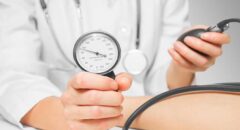When we think about clogged arteries, we immediately think about our heart, but did you know that there are signs of clogged arteries on your feet? Peripheral Artery Disease (PAD) is the buildup of cholesterol and plaque in the arteries that can lead to the extremities.
LIKE DailyVitamina.com on Facebook! Get Your Daily Vitamin…FOR LIFE!
Many times our feet hurt when walking and we think that it’s our old shoes, but it might be PAD. This can cause pain in your legs and feet, limiting your walking and other activities. Just like coronary artery disease, PAD is associated with atherosclerosis, which is a buildup of cholesterol in the arteries and throughout the body. This can point to heart problems, so it’s important to get screened.

Symptoms
- Painful cramping in the leg or hip that occurs when walking or exercising
- Numbness, tingling, burning, aching, or weakness in the toes or feet when laying down
- Color change in the bottom of your feet or on your legs
- Loss of hair in your legs
- Pain in the legs or feet that wakes you up
- Sores on leg or foot that are taking too long to heal
People who are over 50, smokers, people with diabetes, overweight, don’t exercise, have high blood pressure or have a history of heart disease are most at risk for PAD.
The screening process is fairly easy; your doctor can check the pulses of your feet during a routine exam. There should be two pulses that your doctor can detect, which determine whether or not the blood flow to your feet is normal.
Your doctor can also do an ankle brachial index, where he will put blood pressure cuffs on the arm and leg and inflate them to listen to the blood flow of the leg and arm. Your blood pressure in your arm and in your leg should be about the same, but if your leg pressure is half of what your arm is reading, then that’s a problem. This means that your leg arteries have narrowed. Even a drop of as little as 10% in blood pressure can mean you have PAD.
Many times you have to make some lifestyle changes in order to alleviate the symptoms of PAD. Small things like quitting smoking and exercising more can alleviate the symptoms. Some doctors can prescribe medication to lower your cholesterol and high blood pressure, but every case is different.
If you experience any of these symptoms, please visit your doctor so that he could assess the problem and recommend a solution that best meets your needs.






